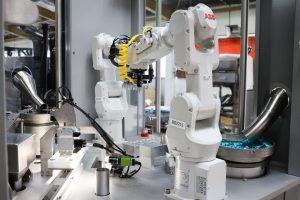EMA & Industry 4.0: Company Profile -RML
RML has been providing high-performance innovative robotic and automation solutions to their customers for the past 40 years. From robotic automation systems, cartoning, case packing, conveyor solutions, custom assembly, palletising, lidders, closers and components.
RML has worked with large and small production lines throughout New Zealand and Australia.
Problem or Opportunity
 As a machine builder, RML have identified key issues which were stopping their customers from maximising the value of their investments. Primarily, it was difficult to be connected to machines from outside of the customers’ plant.
As a machine builder, RML have identified key issues which were stopping their customers from maximising the value of their investments. Primarily, it was difficult to be connected to machines from outside of the customers’ plant.
This led to site visits being required to provide customer support and delivering upgrades that increased customers productivity.
The lack of network connectivity also meant that machines were generally standalone, with limited integration with the customers business systems, thus not delivering the performance data to the teams that are.
The Solution
RML identified that current PLC technology is great for controlling plant, but is lacking in the ability to fully control machines and harness the full potential of Industry 4.0. To make their products Industry 4.0 ready, RML moved to using Industrial Controllers (IC’s) about six years ago.
IC’s are similar to a Windows computer. They have the ability to run real-time control and allow a suite of additional programs to be installed, beyond simple machine controls. This has also helped them bridge the common access or security issues which machine builders face with PLCs.
Using IC’s, it is now easier to support customers in real-time while ensuring security needs are met.
The IC’s allow for the remote adjustment of settings to help when troubleshooting, allowing remote support and troubleshooting, and allowing RML to train new operators online.
This ensures machines are back up and running quickly, effectively maximising production. Also of benefit is the ability to collect real-time data using the PLC that drives the process.
The data generated helps provide improved business performance intelligence and improves growing and grading processes. They also allow for the storage of information at the point of use, like SOP’s or training videos.
These help machine owners to bring their staff up to speed on the machines’ function through an accurate instruction from the OEM.
Historically, it was common to have manual and electrical drawings stored in locations where supervisors and operators did not have immediate access, now the team have access to the latest documents at their fingertips.
| PLC | IC |
| Specialist software required | Standard programming language |
| Easy to program | Unrestricted programming capability |
| Traditionally most robust | Typically, less well shielded from process environments, but not now |
| Can only run machine instructions
|
Can process and report data (graphs, dashboard, Power BI etc) |
| Can output data | Can process and report data (graphs, dashboard, Power BI etc |
| Most secure | More easily integrated into business security framework (allowing external access to machines securely) |
| Hard to upgrade (generally requires code transfer) | Easy to update (common programme language) |
While the machines are running, they are generating both products for the machine owner, but also a large volume of data. RML can, with customers authority, review this data and understand the performance of their products in the field.
This information, when integrated into their design process allows them to create more suitable machines in the future by having a clear understanding of how their machines work in the real world.
The benefits of enabling their machines with this additional functionality speaks to interoperability and real-time capabilities, which are core principles of Industry 4.0.
The feedback generated from the product in-use is part of the concept: “Integrated product life cycle.”
- Interoperability represents the ability for manufacturing systems to exchange information between them for example the MES system being able to communicate how many of each item the machine needs to process and the SKU and even machine parameters for the next product to be made.
- Real-time capabilities as the name suggests, is focused on reducing the lag time between the generation of data and it being available for communication to either people, or software or other manufacturing assets. Reducing this time allows for faster detection of issues and seamless transitions.
- Integrated product lifecycle covers the design, manufacture and ongoing service and support of a product. Data generated by a product in-use can be fed back to the design team to allow for improved design, or to the support team to help service the product before it fails.
Key takeaways
- Interoperability of machines is critical to maximising their potential, this reduces the tasks for operators and makes for a more responsive operation.
- Remote troubleshooting.
- Universal programme language for IC’s, specialist software is not required.
- Real-time visibility of processes allows for faster identification of problems, more robust decision-making, and most importantly, faster deployment of countermeasures.
- By monitoring a process, we can often identify when it is trending away from normal and can identify and execute solutions before it fails.
- Real world data can help in designing products to ensure they meet the actual needs of the customers and their processes.
- IC’s allow for greater interoperability and functionality than PLC’s



